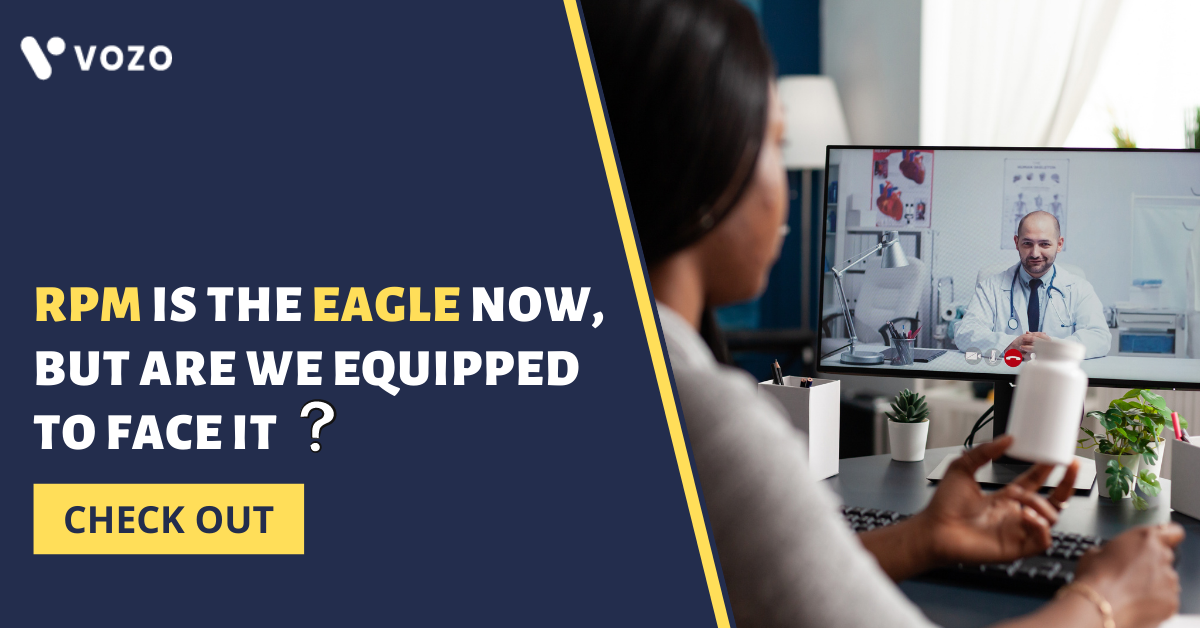RPM Is The Eagle Now, But Are We Equipped To Face It?
As we all know, the healthcare industry is accelerating toward the growth and success of Remote Patient Monitoring (RPM). It became very useful when the pandemic hit the world. Now with all its features, it’s becoming triumphant.
But have you ever thought about being a healthcare staff, are we (“we” here includes the entire healthcare infrastructure) compatible to face the tremendous growth of RPM? No right? We are just tending to adjust things and go with the flow. That’s not the right way for utilizing the true potential of RPM.
Researches show that the global RPM market will rise from $30.5 billion in 2021 to $62 billion in 2027. With the help of healthcare providers, patients, RPM device manufacturers, and the technology that connects them can create an ecosystem where the future of RPM will continue to grow and thrive.
What Is Remote Patient Monitoring (RPM)?

Remote patient monitoring (RPM) is a technology to enable the monitoring of patients outside of conventional clinical settings, such as in the home or in a remote area, which may increase access to care and decrease healthcare delivery costs. RPM involves the constant remote care of patients by their physicians, often to track physical symptoms, chronic conditions, or post-hospitalization rehab.
Incorporating RPM in chronic-disease management may significantly improve an individual’s quality of life, by allowing patients to maintain independence, prevent complications, and minimize personal costs. RPM facilitates these goals by delivering care through telecommunications. This form of patient monitoring can be particularly important when patients are managing complex self-care processes such as home hemodialysis.
Benefits And Disadvantages Of RPM

- The good side of RPM is that the devices used support low-cost healthcare deliveries, wide-ranged access to medical advancements, and new ways of reaching the aged population with the facility of in-home information transfer.
- The COVID-19 pandemic became the reason for the wide-armed acceptance of these technologies by the younger population, which would eventually contribute to the overall boost in world health.
- On the contrary, some patients and even some providers are unaware of the availability of RPM and its pros and lack the knowledge they need for access.
- RPM in some cases increases the possibility of duplicate or fraudulent charges by healthcare providers.
- It also exposes the patients to improper handling of data, including data privacy and security.
- The above mentioned are the main reasons why patients do not opt to use new technologies.
RELATED: Top 5 Challenges Affecting Patient Access To Healthcare
How Remote Patient Monitoring Systems Impact The Healthcare Delivery Drifts

To improve the outcomes, the professional who deals with developing, designing, and manufacturing medical products, works tirelessly.
Improving outcomes here implies or ranges from improved capturing of data, transferring them between HCP, and their patients to enhancing the interface for the technologically challenged.
“Remote” in RPM means patients can get the care delivered from across the world even if they are in a remote place. So “delivery drifts or dynamics” often mean the patients do the monitoring their medical devices and take medications by themselves as prescribed so that it facilitates the HCP to make sure it’s done.
The differences in the theme as a whole are endless, and the industry could be doing more sooner. The approach of RPM solutions by both legacy and new players will be different.
Remote Patient Monitoring Can Only Help The Industry With Some Conditions

Remote Patient Monitoring can cement the cracks made by increased healthcare costs by identifying problems beforehand, reducing the number of emergency cases, managing chronic diseases more intelligently, and facilitating uninterrupted tracking between providers and patients.
Highly efficient and comprehensive monitoring using AI-assisted diagnosis, and treatment will result in more concentration on finishing the work, lower delivery of care, and higher administrative costs.
The privacy of patient data is open to threats in this increasingly digital world. Without honesty from the providers to the patients, RPM cannot result in perfect functioning. All healthcare continuum participants must adhere to HIPAA standards and other regulations to play fairly.
Principled billing must be followed for the system to work efficiently. The patients will not use the RPM devices if they are not satisfied or they do not trust the system.
Find The Perfect RPM Your Practice Needs With Us

It’s very refreshing and hopeful to witness how RPM monitoring devices and products in specialties like cardiac, neurological, respiratory, neonatal, and many more are saving lives daily. Some studies show that the next trend in RPM technology is miniaturization, which is partly used now.
Welcome to VozoEHR. The mastermind who is going to transform your remote mode of delivering care into a more reliable and successful one.
Our RPM allows healthcare providers to monitor & analyze patient healthcare, engage with patients virtually to modify care plans, and educate patients about their healthcare conditions. And it helps both the patients and the providers to manage chronic conditions.
It allows patients to use digitally connected devices – like heart monitors and blood pressure cuffs to perform routine tests and share their health data with a healthcare professional. We are just the best facilitators in between.
For more details visit our website and get started now with us on your journey to more success.
“Let’s make your practice more accessible to people around the world, together”
About the author

With more than 4 years of experience in the dynamic healthcare technology landscape, Sid specializes in crafting compelling content on topics including EHR/EMR, patient portals, healthcare automation, remote patient monitoring, and health information exchange. His expertise lies in translating cutting-edge innovations and intricate topics into engaging narratives that resonate with diverse audiences.













